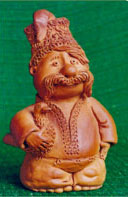Blacksmith Vakula is a character in Nikolai Gogol's story "The
Christmas Night". By the will of the author Vakula makes a deal
with the devil to get for his sweetheart Oksana "the kind of shoes
worn by the empress herself". After getting the shoes, not without
the devil's help, Vakula conquers the heart of Oksana, while the devil,
strange though it may seem, does not get himself anything at all. The
tamMy name o;f the central character of this article is Vakulenko, and,
who knows, it might be a bit more than a mere coincidence.
After visiting the museum in Kaunas (Lithuania) by the name "All
the World's Devils", our character thought for a while and made
a step into the realm of art, for it was that casual visit to the museum
in 1970 that predetermined the life path of the student of Kiev Polytechnic
Mykola Vakulenko. For a start, Mykola did some woodcarving, just for
the fun of it. He had gradually got fascinated with it, concepts were
swarming 'inside his brain and he was eager to embody them in wood.
But the cutting tool always seemed to fall halfway behind the flight
of the author's thought.
Then the desire arose in him to take up clay and try to realize in it
what he had no time to realize in wood.
Mykola started with making devils. The molded figures looked as if they
were carved out ot wood. He didn't give up his habit to thoroughly finish
the surface. That is probably what makes his works charming in their
own special way.
QUESTION: Mykola, why did you start with devils?
ANSWER: I thought it was the simplest form. Q.: Is
that all?
A.: Yes, at first. Then I took liking to it. You do
not have to observe the proportions you have to bear in mind when making
people or animals. Your imagination is absolutely free. Later I took
an interest in the classification of devils advanced by Ukrainian historian
Dmytro Yavornytsky. There are evil, kind and mischievous types. Some
of them live with people — all sorts of house spirits and some fulfill
their duties in the fields, forests or swamps. So I try to make them
all.
Q.: When you realized that clay obeyed you and you
were able to do more than just devils, what did you take up next?
A.: I started shaping people. But still, it happenes,
as I am making a human character I see it does not look right and I
do not like it. Then I mold a pair of horns and some fur, change the
face a bit and it looks like a perfectly normal devil.
It is worth noting that Vakulenko's chaiacters, humans and animals alike,
look like caricatures rather than classic sculptures. That was probably
why Mykola was commissioned to illustrate the book "The Claimants
to Papakha" ty Ukrainian .humor writer Oleh Cliornohuz. It is a
humor story, and the clay characters molded by Vakulenko are completely
in keeping with its spirit.
The Chornohuz' characters are not the only example of Mykola's taking
up literary themes. He also illustrated books by Anton Chekhov, as well
as works of modern Ukrainian literature. Mykola is at his best making
Ukrainian characters. The national features and coloring are present
not only in the way they are dressed. It is also in Iheir postures,
in the way they narrow their eyes, and in every clay smile.
Q.: You went to India last year to take part in the
festival of Soviet-Indian friendship. Could you please tell something
about it?
A.: Well, there isn't much to tell. I represented Ukrainian
folk craft there. I was a member of the delegation of craftsmen of different
genres from the Union republics. We stayed in three cities, where friendship
festivals were staged. I was showing works that I had brought along
with me and was making some simultaneously.
Q.: What was the Indians' reaction to your works,
Mykola?
A.: It was excellent, they even stole some things.
Some praise, isn't it.
But let us get back to the beginning. Did the Kiev Polytechnic student
know when leaving the museum of devils in Kaunas that he would come
back again 14 years later, but already as the author of an exhibition
featuring sculptures of 70 Ukrainian devils? The exhibition was a success,
and the museum purchased 35 of his works, which are now permanently
on display. Usually artists are represented at the museum with no more
than three works.
Many museums display Vakylenko's works today. He participated in numerous
fairs and exhibitions. People recognize his pieces, adding that they
have been familiar with them since they visited the Kaunas museum.
But after all the shows and fairs the 1 master is back to his everyday
life, to work which is "hard to start again even after a week-long
break", and to his apprentices. Now he is working at his next exhibition
to be opened at the art museum in Simferopol. It will be named "The
History of Ukrainian Devils". His brand new idea is to arrange
a big composition "Devils at A Nude Show".
Q.: Now, Mykola, the final question. Your works are
being displayed in numerous museums. Which of them is the dearest to
you?
He gives a smile: "It's the one in Kaunas."
I did not ask why, for I knew the answer. "Vakulenko" in Ukrainian
means "the son of Vakula", and, like the literary ancestor,
he found happiness with the devil's help but without trading his soul
for it.
OLENA KOPALET
Works of Mykola Vakulenko: "Where Have those Stray Souls Gone Astray?"
(left); "Vakulenko and his Muse".
News from Ukraine
#40(1080), October, 1989


 На першу сторінку
На першу сторінку




 На першу сторінку
На першу сторінку